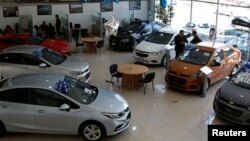A trade group representing U.S. auto parts makers on Monday urged the Trump administration to adopt NAFTA automotive rules that cover research, engineering, design and software development work as part of North American regional value content goals.
The proposal from the Motor and Equipment Manufacturers Association (MEMA) was sent to U.S. Trade Representative Robert Lighthizer as a sixth round of negotiations to revise the North American Free Trade Agreement began in Montreal.
U.S. demands for sweeping changes to automotive content rules are among the most contentious issues in the NAFTA talks, including a requirement that half the value of all North American vehicles come from the United States and a far higher content requirement of 85 percent from North America.
Canada and Mexico have said the U.S. targets are unworkable, but have not responded with counter-proposals.
They are expected to do so at the Montreal talks ending Jan 29. Lack of progress in bridging the gap on autos could jeopardize the negotiations and increase the chances that President Donald Trump follows through on his threat to seek a U.S. withdrawal from NAFTA.
The U.S. auto industry, including MEMA and trade groups representing Detroit and foreign-brand automakers, have largely sided with Canada and Mexico in arguing that the U.S. proposals would hurt the industry's competitiveness.
The MEMA letter to Lighthizer makes no mention of the proposed U.S. and regional content targets, and focuses instead on recommendations that its members believe will help retain and grow automotive jobs in the United States.
"We think it lines up very well with the president's initiatives and his stated goals for NAFTA and other free trade agreements," Ann Wilson, MEMA's senior vice president of government affairs, told Reuters. "What we have been trying to do is find other ways of getting to the president's objectives without getting to a 50 percent domestic requirement."
Counting the well-paid engineering, design, research and software development as part of a vehicle's value content would provide an incentive for companies to retain jobs doing this work now largely done in the United States.
The proposal also urges the Trump administration to preserve "tariff-shifting" for automotive parts as a means to retain the higher value-added work being done on sophisticated automotive electronics and other systems.
Currently, companies that import components and materials into North America and convert them into automotive parts can "shift," or apply, NAFTA tariff-free benefits to such inputs.
For example, off-the-shelf electronics parts from Asia such as lidar and radar units, cameras, sensors and circuit boards currently gain this benefit as they are assembled into vehicle crash avoidance systems. Steel tubing converted to fuel injectors also can gain such benefits.
But the current USTR autos proposal would require that virtually all components be subject to a "tracing list" to verify their North American origin so they can count toward regional value targets.
The tracing list would be expanded to steel, glass, plastic resins and other materials, under the proposal.
Industry executives have argued that these requirements are likely to push auto and parts companies to source more products outside the region and simply pay the low 2.5 percent U.S. tariffs on many parts.
MEMA also urged Lighthizer to negotiate an agreement that provides incentives to U.S. companies to train and expand the U.S. workforce, as parts companies struggle to fill open positions amid rising retirements. The group also urged that aftermarket parts be subject to the same NAFTA rules as original equipment parts.








